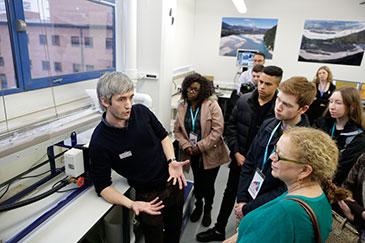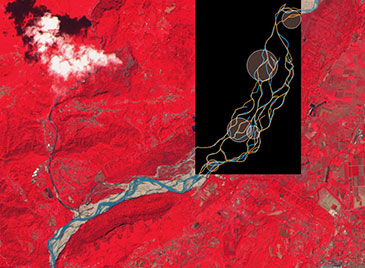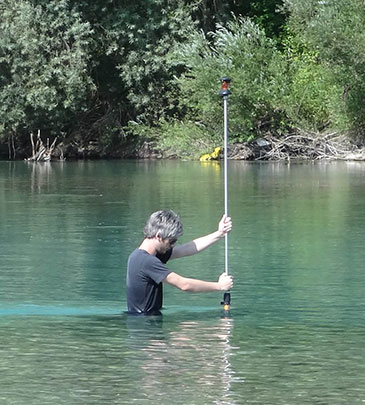Professor Alex Henshaw

Professor of Physical Geography, Interim Head of School
Email: a.henshaw@qmul.ac.uk
Telephone: +44 (0)20 7882 5436
Room Number: Bancroft Building, Room 2.03
Profile
My research focuses on the application of geospatial technologies and numerical approaches to understanding environmental processes, ecosystem service delivery and nature recovery. I am interested in how fluvial systems respond to changes in biota, climate and land management and how remote sensing approaches (LiDAR, photogrammetry and multispectral imaging) can support detection and measurement of environmental changes. I work with interdisciplinary academic teams and diverse non-academic partners to address environmental and societal challenges including increasing resilience to natural hazards, reversing biodiversity loss, and establishing rewilding as an investable nature-based climate solution. I currently hold a NERC Knowledge Exchange Fellowship on Embedding environmental and geospatial science in nature recovery and rewilding (2024-26).
Teaching
 I teach across a range of subject areas including fluvial geomorphology, geospatial science, hydrology, statistics, environmental modelling and river management. Wherever possible, I try to enhance student learning through the illustration of concepts and demonstration of techniques using active research sites and by providing opportunities to work with real research data. Examples of skills developed by students who take the modules I currently teach include flood frequency analysis and hydrodynamic modelling, river habitat assessment and restoration design, surveying and photogrammetry, satellite image analysis and digital cartography.
I teach across a range of subject areas including fluvial geomorphology, geospatial science, hydrology, statistics, environmental modelling and river management. Wherever possible, I try to enhance student learning through the illustration of concepts and demonstration of techniques using active research sites and by providing opportunities to work with real research data. Examples of skills developed by students who take the modules I currently teach include flood frequency analysis and hydrodynamic modelling, river habitat assessment and restoration design, surveying and photogrammetry, satellite image analysis and digital cartography.
Modules taught:
- GEG5223 Geospatial Science (convenor)
- GEG5215 Environmental Research Methods (lecturer)
- GEG6314/GEG7314 Flood Risk Management & Modelling (convenor)
- GEG7317 River Assessment & Restoration (convenor)
- GEG7319 Environmental Data Acquisition & Analysis (lecturer)
Research
Research Interests:
 Morphodynamics of large rivers using emerging Earth observation data sets
Morphodynamics of large rivers using emerging Earth observation data sets
The last decade has seen an explosion in the quality and availability of Earth observation data, providing opportunities to study river processes at spatial and temporal scales that would previously have proved impossible. However, making sense of river morphodynamics in this era of big data presents many research challenges. Highlights in this strand of my research include critical assessment of the potential of archival Landsat data to quantify ecomorphodynamic behaviour in large rivers (Henshaw et al., 2013a); development of automated methods to quantify sedimentary bar and channel morphodynamics in meandering and anabranching rivers (Monegaglia et al., 2018); adaptation of graph theoretical metrics more commonly used in mathematics and neuroscience for structural and behavioural analysis of braided rivers (Connor-Streich et al., 2018); and physically-meaningful remote river reach classification using process-based geomorphic indicators (Henshaw et al., 2019).
Biotic agents of change in fluvial systems
Certain species of plants and animals have the capacity to modify river form and behaviour. These so-called “ecosystem engineers” influence hydrological, hydraulic and sediment transport processes through activities such as root and stem growth, seasonal dieback, burrowing, grazing, etc. These interactions between the biotic and abiotic components of fluvial systems can have important river management implications but also, if harnessed correctly, provide a means to restore natural functioning and resilience in degraded catchments. My research in this area has identified physical controls on the growth of engineering riparian tree species (Henshaw et al., 2013); established the role of invasive burrowing animals as drivers of elevated suspended sediment yields and bank erosion in rivers (Harvey et al., 2014, 2019; Faller et al., 2015); demonstrated how large wood can modify suspended sediment transport in lowland rivers (Parker et al., 2017); and supported the parameterisation of vegetation-hydrogeomorphic process interactions in numerical modelling (Politti et al., 2018). I currently lead a QMUL Collaboration Fund partnership project with Knepp Wildland, a pioneering rewilding project in West Sussex, which aims to quantify natural vegetation regeneration using aerial survey techniques and geospatial analysis.
 Supporting process-based river management and restoration
Supporting process-based river management and restoration
Healthy river ecosystems and the services they provide (e.g. flood protection, erosion control, nutrient cycling) are a product of natural hydrological, sedimentological and ecological processes that operate over a wide range of spatio-temporal scales. The protection, reinstatement and emulation of such processes wherever possible is key to successful river management and restoration but practitioners require knowledge and effective tools to help them identify, understand and resolve problems. My research has supported this through the development of a multi-scale hierarchical assessment framework to underpin river management decisions across Europe (Gurnell et al., 2016); stochastic forecasting of changes in upland catchment sediment yields under future land use and climate change scenarios (Henshaw et al., 2013b); and the development of GIS-based decision-support tools to assist ecosystem service provision through strategic land use management (Jackson et al., 2013).
Publications
- Chalmers, A, Carroll, A, Long, S, de Klee, I, Hay, M, Trewick, L, Biddell, M, Grocott, H, Black, H, Leeson, A, Henshaw, AJ, Harvey, G, Khan, Z. 2024. Knepp Wildland Carbon Project. London: Arup. Technical appendices: Landscape-scale estimation of above-ground biomass using UAV lidar and assessment of low-cost UAVs for monitoring natural regeneration of vegetation.
- Harvey, GL, Hartley, AT, Henshaw, AJ, Khan, Z, Clarke, S, Sandom, C, England, J, King, S, Venn, O. 2024. The role of rewilding in mitigating hydrological extremes: state of the evidence. WIREs Water. doi.org/10.1002/wat2.1710
- Harvey, GL, Henshaw, AJ. 2023. Rewilding and the water cycle. WIREs Water. doi.org/10.1002/wat2.1686
- Walley, Y, Henshaw, AJ. 2022. Topological controls on catchment sediment dynamics. Earth Surface Processes and Landforms. doi.org/10.1002/esp.5510
- Harvey GL, Henshaw AJ, Koch R, Monteith W, Stansfeld K. 2022. BlueGreenE17: co-creating a vision for a wilder Walthamstow.
- Trinci, G, Harvey, GL, Henshaw, AJ, Bertoldi, W. 2022. Turbulent signatures of natural river morphology in four dimensions. River Research and Applications. doi.org/10.1002/rra.4071
- Henshaw AJ, Harvey GL, Walley Y, Green P, de Klee I. 2021. A bird's-eye view of the Wildland: 20 years of vegetation regeneration at a pioneering rewilding project.
- Henshaw AJ, Walley Y, Harvey GL, Green P, de Klee I. 2021. Knepp WildVeg Geodatabase [Data set]. Zenodo. doi.org/10.5281/zenodo.5556945
- Walley, Y, Henshaw, AJ, Brasington, J. 2020. Topological structures of river networks and their regional‐scale controls: A multivariate classification approach. Earth Surface Processes and Landforms. doi.org/10.1002/esp.4936
- Trinci, G, Harvey, GL, Henshaw, AJ, Bertoldi, W, Hölker, F. 2020. Turbulence, instream wood and fish: Ecohydraulic interactions under field conditions. Ecohydrology. doi.org/10.1002/eco.2211
- Henshaw, AJ, Sekarsari, P, Zolezzi, G, Gurnell, AM. 2019. Google Earth as a data source for investigating river forms and processes: Discriminating river types using form‐based process indicators. Earth Surface Processes and Landforms. doi.org/10.1002/esp.4732
- Harvey, GL, Henshaw, AJ, Brasington, J & England, J. 2019. Burrowing invasive species: An unquantified erosion risk at the aquatic‐terrestrial interface. Reviews of Geophysics. doi.org/10.1029/2018RG000635
- Connor‐Streich, G, Henshaw, AJ, Brasington, J, Bertoldi, W, Harvey, GL. 2018. Let's get connected: A new graph theory‐based approach and toolbox for understanding braided river morphodynamics. WIREs Water. doi.org/10.1002/wat2.1296
- Monegaglia, F, Zolezzi, G, Güneralp, I, Henshaw, AJ, Tubino, M. 2018. Automated extraction of meandering river morphodynamics from multitemporal remotely sensed data. Environmental Modelling and Software. doi.org/10.1016/j.envsoft.2018.03.028
- Harvey, GL, Henshaw, AJ., Parker, C, Sayer, CD. 2018. Re-introduction of structurally complex wood jams promotes channel and habitat recovery from overwidening: Implications for river conservation. Aquatic Conservation: Marine and Freshwater Ecosystems. doi.org/10.1002/aqc.2824
- Politti, E, Bertoldi, W, Gurnell, AM, Henshaw, AJ. 2018. Feedbacks between the riparian Salicaceae and hydrogeomorphic processes: A quantitative review. Earth Science Reviews. doi.org/10.1016/j.earscirev.2017.07.018
- Trinci, G, Harvey, GL, Henshaw, AJ, Bertoldi, W, Hölker, F. 2017. Life in turbulent flows: interactions between hydrodynamics and aquatic organisms in rivers. WIREs Water. doi.org/10.1002/wat2.1213
- Parker, C, Henshaw, AJ, Harvey, GL, Sayer, CD. 2017. Reintroduced large wood modifies fine sediment transport and storage in a lowland river channel. Earth Surface Processes and Landforms. doi.org/10.1002/esp.4123
- He, F, Zarfl, C, Bermerich, V, Henshaw, AJ, Darwall, W, Tockner, K, Jähnig, SC. 2017. Disappearing giants: a review of threats to freshwater megafauna. WIREs Water. doi.org/10.1002/wat2.1208
- Faller, M, Harvey, GL, Henshaw, AJ, Bertoldi, W, Bruno, MC, England, J. 2016. River bank burrowing by invasive crayfish: Spatial distribution, biophysical controls and biogeomorphic significance. Science of the Total Environment. doi.org/10.1016/j.scitotenv.2016.06.194
- Politti, E, Bertoldi, W, Henshaw, AJ. 2016. Extending a hydromorphodynamic reduced complexity model with riparian vegetation dynamics, in Webb, JA, Costelloe, JF, Casas-Mulet, R, Lyon, JP, Stewardson, MJ (eds.). Proceedings of the 11th International Symposium on Ecohydraulics. Melbourne, Australia, 7-12 February 2016. The University of Melbourne, ISBN: 9780734053398.
- Politti, E, Bertoldi, W, Henshaw, AJ. 2016. Developing allometric relationships for riparian vegetation friction characterization, in Webb, JA, Costelloe, JF, Casas-Mulet, R, Lyon, JP, Stewardson, MJ (eds.). Proceedings of the 11th International Symposium on Ecohydraulics. Melbourne, Australia, 7-12 February 2016. The University of Melbourne, ISBN: 978-0-7340-5339-8.
- Gurnell, AM, Rinaldi, M, Belletti, B, Bizzi, S, Blameur, B, Braca, G, Buijse, T, Bussenttini, M, Camenen, B, Comiti, F, Demarchi, L, Garcia de Jalon, D, Gonzalez, del Tanago, M, Grabowski, R, Gunn, I, Habersack, H, Hendriks, D, Henshaw, AJ, Klosch, M, Lastoria, B, Latapie, A, Marcinkowski, P, Martinez-Fernandez, V, Mosselmann, E, Mountford, JO, Nardi, L, Okruszko, T, O’Hare, MT, Palma, M, Percopo, C, Surian, N, van de Bund, W, Weissteiner, C, Ziliani, L. 2016. A multi-scale hierarchical framework for developing understanding of river behaviour to support river management. Aquatic Sciences. doi.org/10.1007/s00027-015-0424-5
- Garcia Lugo, AG, Bertoldi, W, Henshaw, AJ, Gurnell, AM. 2015. The effect of lateral confinement on gravel bed river morphology. Water Resources Research. doi.org/10.1002/2015WR017081
- Henshaw, AJ, Bertoldi, W, Harvey, GL, Gurnell, AM, Welber, M. 2014. Large wood dynamics along the Tagliamento River, Italy: insights from field and remote sensing investigations, in Lollino, G, Arattano, M, Rinaldi, M, Giustolisi, O, Marechal, JC, Grant, G (eds.). Engineering Geology for Society and Territory, Volume 3, Proceedings IAEG XII Congress, Springer International Publishing Switzerland.
- Gurnell, AM, Gonzalez del Tanago, M, Rinaldi, M, Grabowski, R, Henshaw, AJ, O’Hare, M, Belletti, B, Bujise, AD. 2014. Development and application of a multi-scale process-based framework for the hydromorphological assessment of European rivers, in Lollino, G, Arattano, M, Rinaldi, M, Giustolisi, O, Marechal, JC, Grant, G (eds.). Engineering Geology for Society and Territory, Volume 3, Proceedings IAEG XII Congress, Springer International Publishing Switzerland.
- Harvey, GL, Henshaw, AJ, Moorhouse, TP, Clifford, NJ, Hoolah, H, Grey, J, Macdonald, DW. 2014. Invasive crayfish as drivers of fine sediment dynamics in rivers: field and laboratory evidence. Earth Surface Processes and Landforms. doi.org/10.1002/esp.3486
- Henshaw, AJ, Gurnell, AM, Bertoldi, W, Drake, NA. 2013. An assessment of the degree to which Landsat TM data can support the assessment of fluvial dynamics, as revealed by changes in vegetation extent and channel position, along a large river. Geomorphology. doi.org/10.1016/j.geomorph.2013.01.011
- Henshaw, AJ, Dangerfield, S, Thorne, CR. 2013. Sediments and geomorphology, in McIntyre, N, Thorne, CR (eds.). Land use management effects on flood flows and sediments – guidance on prediction. CIRIA. ISBN: 978-0-86017-722-7
- Jackson, B, Pagella, T, Sinclair, F, Orellana, B, Henshaw, AJ, Reynolds, B, McIntyre, N, Wheater, H, Eycott, A. 2013. Polyscape: a GIS mapping framework providing efficient and spatially explicit landscape-scale valuation of multiple ecosystem services. Landscape and Urban Planning. doi.org/10.1016/j.landurbplan.2012.12.014
- Henshaw, AJ, Thorne, CR, Clifford, NJ. 2013. Identifying causes and controls of river bank erosion in a British upland catchment. Catena. doi.org/10.1016/j.catena.2012.07.015
- Harvey, GL, Moorhouse, TP, Clifford, NJ, Henshaw, AJ, Johnson, MF, Macdonald, DW, Reid, I, Rice, SP. 2011. Evaluating the role of invasive aquatic species as drivers of fine sediment-related river management problems: the case of the signal crayfish (Pacifastacus leniusculus). Progress in Physical Geography. doi.org/10.1177%2F0309133311409092
Supervision
Please get in touch if you are interested in undertaking a PhD in the following areas:
- Remote sensing and modelling of landscape-scale habitat connectivity in urban environments
- Behavioural analysis of large rivers using Google Earth Engine;
- Measurement of geomorphological and vegetation dynamics using UAV LiDAR;
- Numerical modelling of fluvial system responses to rewilding.
PhD students (current):
- Grace Moore: Animals as geomorphic agents in landscape rewilding. Supervisors: Gemma Harvey (QMUL), Tim Newbold (UCL), Alex Henshaw (QMUL). Expected completion 2026.
- Adam Hartley: Modelling catchment-scale hydrological effects of rewilding. Supervisors: Gemma Harvey (QMUL), Alex Henshaw (QMUL). Funding: QMUL Principal’s Studentship. Expected completion 2025.
- Jordan Bull: Rewilding and Natural Flood Management: Quantifying the hydrological effects of vegetation succession. Supervisors: Gemma Harvey (QMUL), Alex Henshaw (QMUL). Funding: QMUL Principal’s Studentship. Expected completion 2024.
PhD students (completed):
- William Flynn: Technological advances in close range sensors and methodological complexities for measuring forest structure and disturbance. Supervisors: Emily Lines (Cambridge), Stuart Grieve (QMUL), Alex Henshaw (QMUL). Awarded 2023.
- Yasmin Walley: Source-to-sink modelling of sediment dynamics in the South Island of New Zealand. Supervisors: Alex Henshaw (QMUL), James Brasington (Waikato). Funding: QMUL Principal’s Studentship. Awarded 2020.
- Gabriel Connor-Streich: Graph theoretical analysis of braided rivers. Supervisors: Alex Henshaw (QMUL), Gemma Harvey (QMUL). Funding: QMUL Strategic PhD Studentship in River Science. Awarded 2019.
- Fengzhi He: Diversity and risk patterns of freshwater megafauna: A global perspective. Supervisors: Sonia Jähnig (IGB Berlin), Christiane Zarfl (Tübingen), Alex Henshaw (QMUL), Klement Tockner (IGB Berlin). Funding: EU Erasmus Mundus Joint Doctorate SMART programme. Awarded 2019.
- Bishnu Raj Baral: Numerical modelling of braiding processes in gravel bed rivers. Supervisors: James Brasington (QMUL), Alex Henshaw (QMUL), Walter Bertoldi (Trento). Funding: EU Erasmus Mundus Joint Doctorate SMART programme. Awarded 2018.
- Matej Faller: Ecosystem engineering impacts of invasive species on river banks: signal crayfish and Himalayan balsam. Supervisors: Gemma Harvey (QMUL), Alex Henshaw (QMUL), Walter Bertoldi (Trento), Cristina Bruno (Fondazione Edmund Mach). Funding: EU Erasmus Mundus Joint Doctorate SMART programme. Awarded 2018.
- Federico Monegaglia: Meandering rivers morphodynamics: integrating nonlinear modelling and remote sensing. Supervisors: Marco Tubino (Trento), Alex Henshaw (QMUL), Guido Zolezzi (Trento). Funding: EU Erasmus Mundus Joint Doctorate SMART programme. Awarded 2017.
- Emilio Politti: Investigating and modelling interactions among vegetation, hydrodynamics and morphology. Supervisors: Walter Bertoldi (Trento), Alex Henshaw (QMUL). Funding: EU Erasmus Mundus Joint Doctorate SMART programme. Awarded 2017.
- Joe James: Three-dimensional reconstruction of braided river morphology and morphodynamics with Structure-from-Motion photogrammetry. Supervisors: James Brasington (QMUL), Alex Henshaw (QMUL). Awarded 2017. Funding: NERC.
- Giuditta Trinci: Spatial organisation of ecologically relevant high order flow properties and implications for river habitat assessment. Supervisors: Alex Henshaw (QMUL), Gemma Harvey (QMUL), Walter Bertoldi (Trento), Franz Hölker (IGB Berlin). Funding: EU Erasmus Mundus Joint Doctorate SMART programme. Awarded 2017.
- Prima Sekarsari: Classifying single-thread rivers: a European perspective. Supervisors: Angela Gurnell (QMUL), Guido Zolezzi (Trento), Alex Henshaw (QMUL). Funding: EU Erasmus Mundus Joint Doctorate SMART programme. Awarded 2015.
- Grecia Alejandra Garcia Lugo: Braided rivers: an exploratory study combining flume experiments and the analysis of remotely-sensed data. Angela Gurnell (QMUL), Alex Henshaw (QMUL), Walter Bertoldi (Trento). Funding: EU Erasmus Mundus Joint Doctorate SMART programme. Awarded 2015.